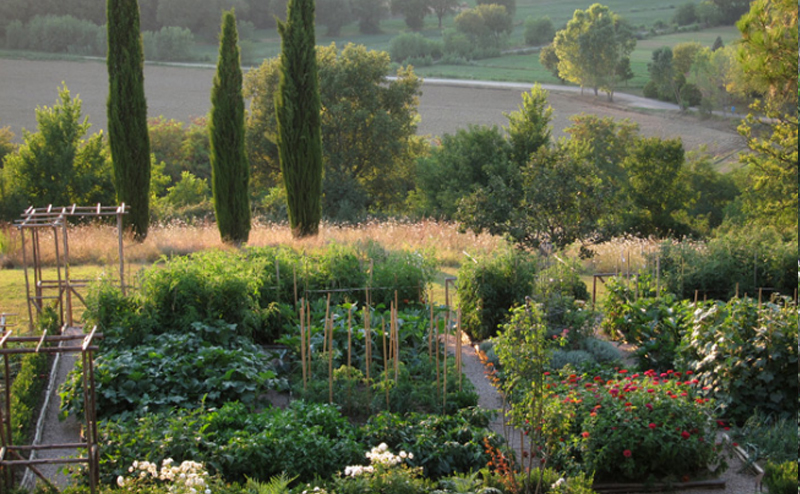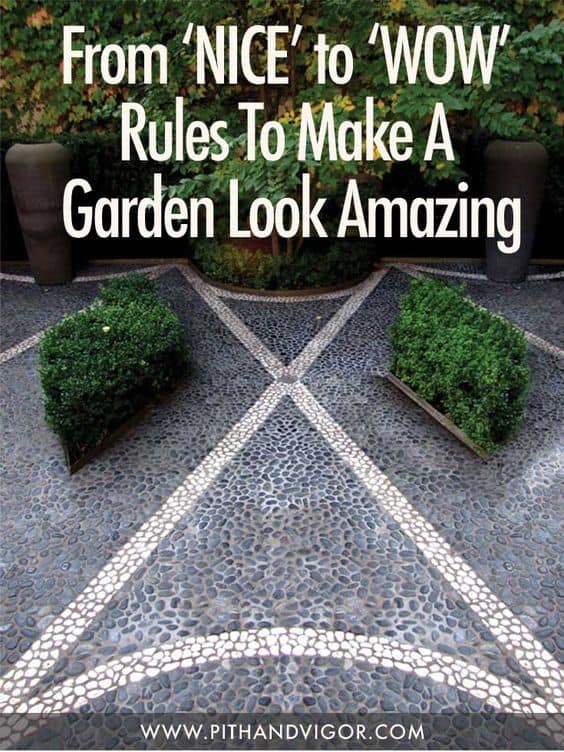There is one word I loathe above all others: nice. As a garden designer, being told my work is “nice” is like being served lukewarm coffee. It’s uninspiring, unremarkable, and frankly, a little insulting. If you’re here for “nice” garden ideas, this isn’t the post for you. But if you’re ready to take your landscape from “meh” to “magnificent,” keep reading.
Let’s ditch “nice” and aim for beautiful, bold, and memorable with these five essential garden design tips.
This is ‘Nice’:

I don’t want nice garden ideas. I want ‘wow’ – so here are my top garden design tips to make any landscape better.
‘Pretty’ is the enemy of ‘Beautiful’
-Nonna Giuliana
1. Define the Mood: Let Your Garden Style Speak Loudly
Think of your garden as an immersive experience—like choosing a restaurant for a date night. Craving Italian? You’re thinking wood-fired pizza, fresh basil, and warm Mediterranean tones. Vietnamese? You’re transported by lime, star anise, and pho.
Your garden should evoke a similarly vivid response. It should speak a clear “language” and set the tone from the first glance. But beware—a confused garden style is like a mixed metaphor; it just doesn’t work.
Here is another example:

I’m sure that you only need to look at that bob haircut, the sunglasses, and those chunky necklaces to recognize Anna Wintour.
The point? It’s possible to describe a mood (or a person, a look, a style) with only a few defining characteristics.
How to Create a Mood in Your Garden:
- Focus on key elements. Use the Pareto Principle: 20% of your design choices will create 80% of the effect. For example, a country garden might feature:
- An informal atmosphere
- Masses of plants
- Limited, uneven hard surfaces
- Research visual references. Look at images of gardens in your desired style and note the common elements.
- Get a second opinion. Discuss your mood board with someone you trust to ensure your vision is coming through clearly.
An example of applying the Pareto principle to a backyard garden design idea
The Pareto Principle, also called the 80/20 rule, says that 20% of the input creates 80% of the result.
By this logic – if you want to create a mood or a look for your garden, you just have to find the 2 or 3 things that express clearly what we are talking about (the 20%), like the bob haircut, the sunglasses, and the necklaces in the Anna Wintour example.
The best way to figure out these qualities is to examine pictures that show that mood and figure out what they have in common. Let’s say you want to design a country garden. If you google ‘country garden’ and then click on ‘Images’. This is what you might see:

What do these garden pics have in common?
- Informal atmosphere
- Masses of plants
- Hard surfaces are uneven and limited in size
(This is our 20% for defining a country garden)
Take a look at this beautiful garden in Umbria, Italy, by Niccolo’ Grassi, an Italian Landscape and Garden Designer:




What do you notice? An informal atmosphere? Masses of plants? Uneven and limited hard surfaces? The perfect country garden is served!
The Pet Cemetery Garden Case Study:
A glimpse should immediately tell the world what it is about. What ‘language’ are you speaking, and what mood are you evoking? I’m amazed how often gardens look confused, or worse – completely different from what they meant. Look, for example, at this picture:

This garden, designed by James Basson, won the Gold Medal and Best Show Garden at the Chelsea Flower Show. It was quite controversial: some liked it, and some didn’t. For many it gave ‘pet cemetery’ vibes.
Pro Tip: Want a garden to look harmonious? Avoid elements that might remind people of… a pet cemetery. (Looking at you, limestone blocks.)
How To Find the Right Design References
Now we have to solve the problem of choosing the right references so that our garden doesn’t look wrong. If someone as talented as James Basson, who has many years of experience, can make this mistake, the solution to this problem is not easy.
I only see two possibilities:
- Increase your knowledge: the more you know, the less likely you will be to pick up the wrong references. (Cultivating Garden Style – my book – defines twenty-three different garden styles and shares the main elements of each to help you find the right references for your design))
- Once you define your mood, discuss it with somebody you trust. Often, we fall in love with our own ideas and lose objectivity. Listening to other people’s impressions helps us understand if the message we are sending out there is heard loud and clear.
2. Perfect Proportions: Why Scale Matters
In design, proportion is king. Without it, even the most meticulously planned garden will feel off. Proportion ensures that every element—from a pergola to a pathway—feels harmonious and balanced.
In a well-proportioned composition, all the parts have the right dimension and scale compared to the others. If the proportions are well conceived, walking through a room, sitting on a chair, or chilling in a garden is comfortable and harmonious. It’s like wearing a bespoke suit: it fits perfectly.

Use the Golden Ratio
The Golden Ratio (approximately 1:1.618) has been the backbone of design masterpieces for centuries. It’s the magic number that makes everything from the Mona Lisa to modern architecture feel “just right.”
How to Apply It:
- A pathway that’s 1 meter wide should be flanked by 1.6 meters of garden.
- A pergola’s height can follow the same ratio compared to its width or length.
When in doubt, check your proportions against the Golden Ratio and adjust. It’s a design superpower that’s surprisingly easy to use.
I used the golden rectangle in this garden to define all the prominent lines of the project:

If you are in doubt about the proportion and the scale of your design, check if they are close to the Golden Ratio and adjust.
3. More Plants, More Wow: Don’t Skimp on Greenery
If your garden looks sparse, the problem is simple: you need more plants. Most garden disappointments stem from underplanting. Those lush magazine gardens? They’re packed to the brim with plants.
Overplant, Then Edit
- Start small, but plant densely. Smaller plants are cheaper, and planting more of them creates an immediate impact.
- Don’t rely on mulch. Mulch is a crutch; plants are the real stars. Cover every inch with greenery to achieve that lush look.
Landscape architect Maurizio Usai is a master of this approach. His Sardinian gardens overflow with plants, creating a tapestry of textures and colors that’s nothing short of breathtaking. If you look at these pictures, I am sure that you agree with me when I say that every inch of the garden is filled with plants.



When I am planting a garden, I drastically “overplant” (if we are to go by the spacing recommendations on the plant tags). I mostly try to choose plants as small as I can (smaller plants cost less), and I make up for it by planting much more. Plant densely, and your garden will be healthier, more lush, and more like the pictures you see in magazines.
4. Details Matter: Elevate Your Garden with Thoughtful Touches
“God is in details”
-Mies van der Rohe
Mies was right: details take every design to another level; details step it up.
Flowers, leaves, textured foliage, and unusual finishes will help your design to become more interesting. The more you pay attention to getting the details of your garden design right, the more your design will carry value and have a timeless appeal.
Great design is all about the details. In gardens, these details could be:
- Textured foliage
- Unusual finishes
- Contrasting elements like smooth pebbles and large, graphic plants

Examples of Detail-Driven Design:
- A black-and-white pebble mosaic that transforms a plain terrace.
- Tiny, textured foliage that creates visual interest and dynamic light play.
The more details you incorporate, the richer your garden’s personality becomes. Remember, it’s the small things that set your garden apart.
Design in is the Details – A Small Space Garden Example:
This project was in a small space. To avoid a sense of confusion, I used a limited material palette, and I chose plants with tiny and extremely textured foliage. You can see in the image above because of the light play; it’s like having a million pixels of different shades of green.
You can’t overdo thoughtful design – the more details, the richer the garden.
Have a look at this other project. Here I designed paving using small black and white pebbles, and I used graphic plants:

The contrast between the large foliage and the textured mosaic perfectly suits this project!
If you look at both pictures, you notice how your eyes can’t stop jumping around from one detail to the next, like bees in a meadow.
This is what the details are for. A plain and simple composition gets boring quickly because there’s not so much to see. On the other details, keep interest high.
5. Break the Rules: Have Fun with Garden Design
Rules are meant to guide, not constrain. Once you’ve mastered the basics, don’t be afraid to experiment. Step out of your comfort zone, try new things, and embrace the possibility of failure. That’s where innovation happens.
TL;DR: Five Steps to a Stunning Garden
- Set the Mood: Define your garden’s style with a few key elements.
- Perfect Proportions: Use the Golden Ratio for balance and harmony.
- Plant Generously: Overplant for that lush, magazine-worthy look.
- Focus on Details: Add thoughtful touches to elevate your design.
- Break the Rules: Push boundaries and have fun.
Let’s leave “nice” behind. Your garden deserves to be a showstopper—beautiful, bold, and unmistakably you.
Ciao!
– Carlo Gabriele for PITH+VIGOR
About Pith and Vigor: Pith and Vigor refers to a lively and vigorous spirit or energy. It is often used to describe someone filled with enthusiasm and vitality. This phrase signifies a strong and robust attitude towards life, embodying a sense of determination and grit – exactly what is needed when cultivating the land with artistry, intelligence, and grace.
Images: The M&G Garden designed by James Basson, photo: Alessandro Martinelli, courtesy of Carlo Gabriele, I Fontanili garden, design by Maurizio Usai. Photo: Maurizio Usai
Related Garden Design Basics Posts:
Share this post:





great post!
Thanks Katherine!
Love love love. Thank you!
“How to avoid our garden reminding anyone of a pet cemetery?” a good question, I will ask myself before each my new garden design 🙂
Great post. I love this article. Thanks for sharing.
Great article! And great job with a pebbles. 🙂 Thanks for pointing out how important is attention to details.
This post is very helpful indeed. Check out this landscaping resource that was also helpful for me: rebrand.ly/7250l86f6
For 25 years I have be dreaming of making over my back yard in the city starting with what I want it to look like in the winter. I haven’t gotten to it yet but I have accumulated bits & pieces to help me when I retire next year. Your information has been beyond helpful. Thank you for sharing so that novices like me can learn and do things right from the start–myself. You are a gift to all of us. ~ Andrea